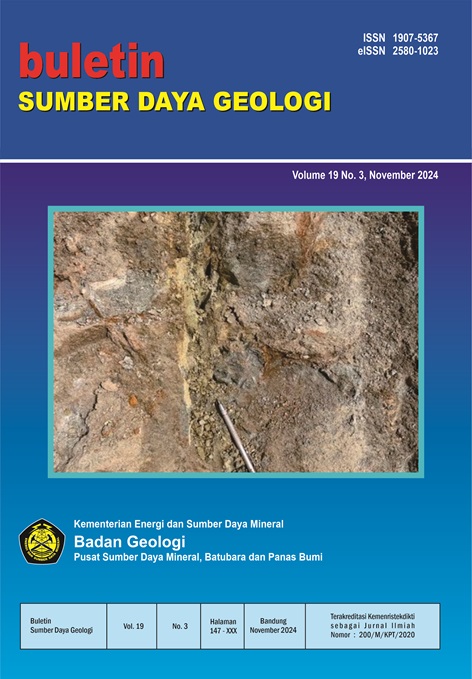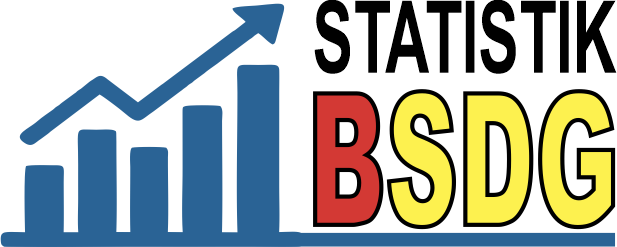KARAKTERISASI BATUAN INDUK HIDROKARBON DAN RESERVOAR NONKONVENSIONAL DI CEKUNGAN JAWA TIMUR BAGIAN UTARA
CHARACTERIZATION OF HYDROCARBON SOURCE ROCKS AND UNCONVENTIONAL RESERVOIR IN THE NORTHERN EAST JAVA BASIN
Abstrak
Cekungan Jawa Timur bagian utara merupakan salah satu cekungan penghasil hidrokarbon di Indonesia dengan lapisan batuan induk yang tebal dan menarik untuk dipelajari sebagai potensi reservoar nonkonvensional di masa mendatang. Integrasi analisis data sumur dan inversi seismik digunakan untuk mengidentifikasi karakteristik batuan induk dalam penelitian ini. Analisis data sumur dapat memberikan informasi litologi pada formasi pembawa batuan induk hidrokarbon, yaitu serpih Formasi Prupuh, serpih Formasi Kranji, dan batugamping Formasi Ngimbang. Data log juga dapat memberikan informasi prediksi nilai Brittleness Index (BI) dan Total Organic Carbon (TOC) di zona target. Regresi linier digunakan untuk menyebarkan BI, porositas, dan TOC pada data seismik. Untuk membantu proses penyebaran nilai TOC dan BI pada parameter seismik, inversi Acoustic Impedance (AI) dilakukan dengan menggunakan metode model based hard constraint untuk memprediksi distribusi AI. Hasil studi ini menunjukkan bahwa zona target merupakan zona potensial dengan kategori menengah hingga potensial dari distribusi TOC 1,5%-2,2%, BI 0,2-0,46, dan porositas 0,03-0,15. Data inversi seismik juga membantu penyebaran parameter petrofisika pada kondisi lateral yang baik mengikuti persebaran horizon batuan induk serpih.
##plugins.generic.usageStats.downloads##
Referensi
Anbazhagan, P., 2021. Seismic Site Characterization of Chennai City, India Using Ambient Vibration and Seismic Refraction Survey. Journal of the Geological Society of India, 97(5), p.575-582.
Anees, A., Zhang, H., Ashraf, U., Wang, R., Thanh, H. V., Radwan, A. E. & Shi, W., 2022. Sand-ratio distribution in an unconventional tight sandstone reservoir of Hangjinqi area, Ordos Basin: Acoustic impedance inversion-based reservoir quality prediction. Frontiers in Earth Science, 10, 1018105.
Bello, O. A., 2021. Petroleum System and Evaluation of the Hydrocarbon Potential of the Eastern Dahomey Basin, Nigeria.. Journal of Petroleum Technology and Alternative Fuels, 12(3), p. 25-43.
Bintarto, 2020. Pemetaan Singkapan Di Indonesia Berdasarkan Pada Karakteristik Reservoar Migas Studi Kasus Cekungan Jawa Timur Utara. Yogyakarta: Fakultas Teknologi Mineral, Universitas Pembangunan Nasional “Veteran”.
Charsky, A. & Herron, S., 2013. Accurate, direct total organic carbon (TOC) log from a new advanced geochemical spectroscopy tool: Comparison with conventional approaches for TOC estimation. Search and Discovery, 41162(1), p.1-17.
Cyz, M. & Azevedo, L., 2020. Direct geostatistical seismic amplitude versus angle inversion for shale rock properties. IEEE Transactions on Geoscience and Remote Sensing, 59(6), p.5335-5344.
Dubey, A., Mohamed, M. I., Salah, M. & Algarhy, A., 2019. Evaluation of the rock brittleness and total organic carbon of organic shale using triple combo. In SPWLA Annual Logging Symposium (p. D043S009R001). SPWLA.
Fertl, W. H. & Chilingar, G. V., 1988. Total organic carbon content determined from well logs. SPE formation evaluation, 3(02), p.407-419.
Gahana, A. G., 2019. Karakterisasi Reservoir Menggunakan Analisis Petrofisika Pada Lapangan Y Formasi Talang Akar Cekungan Sumatera Selatan. Geoscience Journal 3.1, h.29-37.
Gogoi, T. & Chatterjee, R., 2020. Multimineral modeling and estimation of brittleness index of Shaly sandstone in Upper Assam and Mizoram areas, India. SPE Reservoir Evaluation & Engineering, 23(02), p.708-721.
Green, S. & Vernik, L., 2021. Correcting density/sonic logs for total organic carbon to reduce uncertainty in pore pressure prediction. Geophysical Prospecting, 69(3), p.586-597.
Guo, Z., Li, X. Y., Liu, C., Feng, X. & Shen, Y., 2013. A shale rock physics model for analysis of brittleness index, mineralogy and porosity in the Barnett Shale. Journal of Geophysics and Engineering, 10(2), 025006.
Kamali, M. R. & Mirshady, A. A., 2004. Total organic carbon content determined from well logs using ΔLogR and Neuro Fuzzy techniques. Journal of petroleum Science and Engineering, 45(3-4), p.141-148.
Li, J., Du, C. M. & Zhang, X., 2011. Critical evaluation of shale gas reservoir simulation approaches: Single-porosity and dual-porosity modeling. In SPE middle east unconventional gas conference and exhibition. OnePetro.
Lu, M., Cao, H., Sun, W., Yan, X., Yang, Z., Xu, Y. & Ouyang, M., 2019. Quantitative prediction of seismic rock physics of hybrid tight oil reservoirs of the Permian Lucaogou Formation, Junggar Basin, Northwest China. Journal of Asian Earth Sciences, 178, p.216-223.
Lu, C., Ma, L., Guo, J., Li, X., Zheng, Y., Ren, Y. & Yang, B., 2022. Novel method and case study of a deep shale fracability evaluation based on the brittleness index. Energy Exploration & Exploitation, 40(1), p.442-459.
Mahmoud, A.A.A., Elkatatny, S., Mahmoud, M., Abouelresh, M., Abdulraheem, A. & Ali, A., 2017. Determination of the total organic carbon (TOC) based on conventional well logs using artificial neural network. International Journal of Coal Geology, 179, p.72-80.
Memon, A., Li, A., Jacqueline, N., Kashif, M. & Ma, M., 2020. Study of gas sorption, stress effects and analysis of effective porosity and permeability for shale gas reservoirs. Journal of Petroleum Science and Engineering, 193, 107370.
Meng, F., Wong, L. N. Y. & Zhou, H., 2021. Rock brittleness indices and their applications to different fields of rock engineering: A review. Journal of rock mechanics and geotechnical Engineering, 13(1), p.221-247.
Nuryanto, A. B. & Santosa., 2014. "Evaluasi Formasi Menggunakan Data Log dan Data Core pada Lapangan "X” Cekungan Jawa Timur Bagian Utara.". Jurnal Sains dan Seni ITS 3.2, p.B112-B117.
Panjaitan, S., 2010. Prospek Migas pada Cekungan Jawa Timur dengan Pengamatan Metode Gayaberat. Buletin Sumber Daya Geologi, 5(3), h.168-181.
Pringgoprawiro, H., 1983. Biostratigraphy and Paleogeography of North East Java Basin: A New Approach. Institute of Technology Bandung.
Purnama, D. I., 2020. Identifikasi Potensi Batuan Induk pada Formasi Santul di Sub-Cekungan Tarakan, Kalimantan Utara. Prisma Fisika, 8(1), p.1-4.
Qiang, Z., Yasin, Q., Golsanami, N. & Du, Q., 2020. Prediction of reservoir quality from log-core and seismic inversion analysis with an artificial neural network: A case study from the Sawan Gas Field, Pakistan. Energies, 13(2), 486.
Ruiz, R., Roubickova, A., Reiser, C. & Banglawala, N., 2021. Data mining and machine learning for porosity, saturation, and shear velocity prediction: recent experience and results. First Break, 39(7), p.71-76.
Sheng, G., Javadpour, F. & Su, Y., 2019. Dynamic porosity and apparent permeability in porous organic matter of shale gas reservoirs. Fuel, 251, p.341-351.
Sohail, G. M., Radwan, A. E. & Mahmoud, M., 2020. A review of Pakistani shales for shale gas exploration and comparison to North American shale plays. Energy Reports, 8, p.6423-6442.
Tian, Z. Y., Guio, R., Yi, L. P. & Wang, H., 2022. The New Porosity Interpretation Models Based on Acoustic Time Log Within Larger Porosity Ranges for Bioclastic Limestone Reservoirs with High Porosity and Low Permeability, Middle East. In International Field Exploration and Development Conferencep. Singapore: Springer Nature Singapore. p.1721-1735.
Valentín, M. B., Bom, C. R., Compan, A. L. M., Correia, M. D., de Jesus, C. M., de Lima Souza, A. & Faria, E. L., 2018. Estimation of permeability and effective porosity logs using deep autoencoders in borehole image logs from the brazilian pre-salt carbonate. Journal of Petroleum Science and Engineering, 170, p.315-330.
Wang, X., Ma, J. F., Zhang, X. T., Wang, Z. L., Wang, F. L., Wang, H. F. & Li, L., 2020. Prediction of total organic carbon content by a generalized ΔlogR method considering density factors: illustrated by the example of deep continental source rocks in the southwestern part of the Bozhong sag. Progress in Geophysics, 35(4), p.1471-1480.
Wood, D. A., 2021. Brittleness index predictions from Lower Barnett Shale well-log data applying an optimized data matching algorithm at various sampling densities. Geoscience Frontiers, 12(6), 101087.
Yang, B., Xue, L., Duan, Y. & Wang, M., 2021. Correlation study between fracability and brittleness of shale-gas reservoir. Geomechanics and
Geophysics for Geo-Energy and Geo-Resources, 7, p.1-13.
Yasin, Q., Du, Q., Sohail, G. M. & Ismail, A., 2017. Impact of organic contents and brittleness indices to differentiate the brittle-ductile transitional zone in shale gas reservoir. Geosciences Journal, 21, p.779-789.
Yasin, Q., Sohail, G. M., Ding, Y., Ismail, A. & Du, Q., 2020. Estimation of petrophysical parameters from seismic inversion by combining particle swarm optimization and multilayer linear calculator. Natural Resources Research, 29, p.3291-3317.
Ye, Y., Tang, S., Xi, Z., Jiang, D. & Duan, Y., 2022. A new method to predict brittleness index for shale gas reservoirs: Insights from well logging data. Journal of Petroleum Science and Engineering, 208, 109431.
Zhang, B., Zhao, T., Jin, X. & Marfurt, K. J., 2015. Brittleness evaluation of resource plays by integrating petrophysical and seismic data analysis. Interpretation, 3(2), p.T81-T92.
Zhang, D., Ranjith, P. G. & Perera, M. S. A., 2016. The brittleness indices used in rock mechanics and their application in shale hydraulic fracturing: A review. Journal of petroleum science and Engineering, 143, p.158-170.
Zhang, K., Song, Y., Jiang, Z., Xu, D., Li, L., Yuan, X., & Chen, X., 2022. Quantitative Comparison of Genesis and Pore Structure Characteristics of Siliceous Minerals in Marine Shale With Different TOC Contents–A Case Study on the Shale of Lower Silurian Longmaxi Formation in Sichuan Basin, Southern China. Frontiers in Earth Science, 10, p.887160.
Zhishui, L. & Zandong, S., 2015. New brittleness indexes and their application in shale/clay gas reservoir prediction. Petroleum exploration and development, 42(1), p.129-137.
##submission.copyrightStatement##
##submission.license.cc.by-nc-sa4.footer##Penulis yang naskahnya diterbitkan menyetujui ketentuan sebagai berikut:
Hak publikasi atas semua materi naskah jurnal yang diterbitkan/dipublikasikan dalam situs Buletin Sumber Daya Geologi ini dipegang oleh dewan redaksi dengan sepengetahuan penulis (hak moral tetap milik penulis naskah).
Ketentuan legal formal untuk akses artikel digital jurnal elektronik ini tunduk pada ketentuan lisensi Creative Commons Attribution-ShareAlike (CC BY-SA), yang berarti Buletin Sumber Daya Geologi berhak menyimpan, mengalih media/format-kan, mengelola dalam bentuk pangkalan data (database), merawat, dan mempublikasikan artikel tanpa meminta izin dari Penulis selama tetap mencantumkan nama Penulis sebagai pemilik hak cipta.
Naskah yang diterbitkan/dipublikasikan secara cetak dan elektronik bersifat open access untuk tujuan pendidikan, penelitian, penyelidikan, dan perpustakaan. Selain tujuan tersebut, dewan redaksi tidak bertanggung jawab atas pelanggaran terhadap hukum hak cipta.















